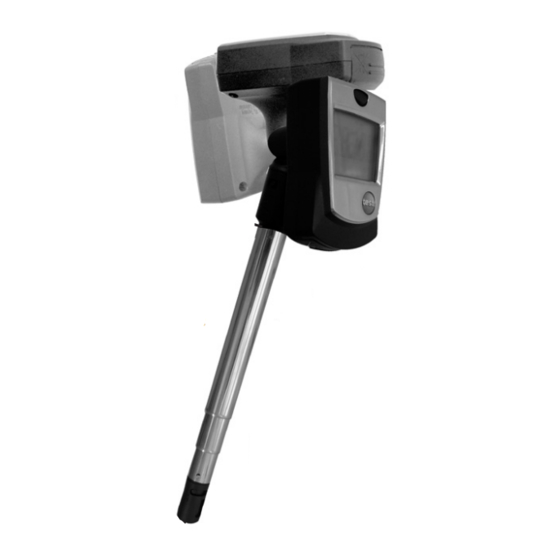
Table of Contents
Advertisement
Available languages
Available languages
Quick Links
Instruction manual
An arrow on the protective cap shows the wind
direction in which the instrument was calibrated
and the best readings obtained.
Commissioning
Remove the protective film on the display.
Switching on
Press button once
Segmenttest
Current reading
Changing the parameters
Press button repeatedly:
Velocity
Temperature
Set duct cross-section m
Keep On button pressed when switching on.1st
position flashes.
1 Keep On button pressed until desired digit appears.
Wait 2 seconds and the digit will apply. The cursor
then changes to the next position.
2 Repeat the described procedure for all positions.
Multi-purpose clip
Holder for positioning
stick in duct.
Twist ring: The lower part
of the probe stem can
be twisted by 90°. This
allows an optimum view
of the display
Protective cap:
The velocity sensor is
protected by a quick
twist of the bottom of
the probe stem
the
protective cap is closed.
Should only be left open
for the duration of the
measurement.
Swivel head. The display
can always be read.
Volume
2
Thermo-Anemometer · testo 405-V1
Switching off
Keep button pressed for 3 seconds.
Technical data
Type of application: ..................................................Short measurement
Measuring range m/s: ..........................................0 to 5m/s at -20 to 0°C;
Measuring range m3/h: ................................................0 to 99990 m3/h
Measuring range °C: ..........................................................-20 to +50 °C
Resolution: ....................................................................0.01 m/s; 0.1 °C
Accuracy: (system accuracy at calibration temp. +25°C)
Ambient temperature: ............................................................0 to +50 °C
Storage temperature: ........................................................-20 to +70 °C
Battery type: ................................................................................3 x AAA
Battery lifetime: ..................................................................Approx. 20 h
(approx. 750 measurements lasting 2 minutes each)
Probe stem: ........................................................Ø 0.5 in/0.6 in / Length:
Warranty: ....................................................................................2 years
CE guideline ....................................................................2004/108/EEC
Please read before using instrument
• Observe flow direction
• Adhere to sensor measuring ranges
• Do not exceed maximum storage and operating
temperatures (e.g. protect measuring instrument
from direct sunlight)!
• Inexpert handling cancels your warranty.
Changing the battery
The battery has to be changed if the
appears in the display during the measurement.
Instrument is switched off.
1 Open battery compartment cover.
2 Remove spent batteries and insert new batteries
(3 x AAA) into the battery compartment. Observe
polarity!
3.Close battery compartment cover.
Auto Off function
If no button has been pressed in approx.5 minu-
tes, the instrument switches itself off
automatically.
0 to 10 m/s at 0 to +50 °C
±(0.1 m/s + 5 % of m.v.) (to 2 m/s);
±(0.3 m/s + 5% of m.v.) (over 2 m/s)
5.9 to 11.8 in
symbol
en
± 0.5 °C
Advertisement
Table of Contents

Summary of Contents for TESTO 405-V1
- Page 1 Thermo-Anemometer · testo 405-V1 Instruction manual Multi-purpose clip Switching off Holder for positioning Keep button pressed for 3 seconds. stick in duct. Twist ring: The lower part of the probe stem can Technical data be twisted by 90°. This Type of application: ..........Short measurement allows an optimum view Measuring range m/s: ..........0 to 5m/s at -20 to 0°C;...
- Page 2 Termoanemómetro · testo 405-V1 Manual de instrucciones Clip multi-uso 2 Repetir el procedimiento anteriormente descrito para Sujeciones para posi- todas las posiciones. cionar el mini en con- Desconexión ducto, ej. en un con- ducto de aire, ver fig. Presionar la tecla durante 3 segundos.
















Need help?
Do you have a question about the 405-V1 and is the answer not in the manual?
Questions and answers
Здравия УТЕРЯНА КРЫШКА БАТАРЕЙНОГО ОТСЕКА. МОЖНО ФОТО КРЫШКИ С ВНУТРЕННЕЙ СТОРОНЫ С РАСПОЛОЖЕНИЕМ КОНТАКТНЫХ ПЛОЩАДОК. ПОД БАТАРЕЙКИ.ЗАРАНЕЕ БЛАГОДАРЮ...